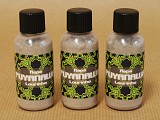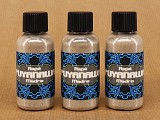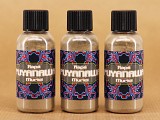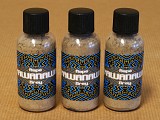Bottle, 10 Ml, 7 Gr from Brazil (SKU 3763)
(Batch #3645). Puyanawa Pixuri is a brown Rapé blend crafted by a Pajé of the Puyanawa tribe in Acre, Brazil. It features Arapiraca and Sabia Corda Tabaco, Murici ashes, and aromatic Pixuri leaves (Licaria puchury), known for their cleansing and clarifying presence. Strong on the onset and deeply grounding, it delivers a warming burn followed by clarity, emotional stillness, and refreshed breath. The blend embodies the Puyanawa’s ceremonial tradition, combining earthy Tabaco with uplifting plant allies. Murici adds energetic balance, while Pixuri infuses the blend with its minty, woody aroma. More information below in the description.
Packed in 10 ml clear plastic bottles containing 7 gr.
Prices below have been reduced by 15% for a limited time.
Puyanawa Pixuri – A Brown Rapé of Grounding Strength and Aromatic Clarity
Function and Composition
Puyanawa Pixuri is a traditional Rapé blend prepared by a Pajé of the Puyanawa tribe in Acre, Brazil. It is composed of Arapiraca and Sabia Corda Tabaco, Murici ashes, and the aromatic leaves of the Pixuri tree (Licaria puchury). This is considered a brown Rapé, with a high proportion of Tabaco and relatively low ash content, giving it a rich, earthy character and a deep grounding effect. The inclusion of Pixuri leaf brings a pleasant scent and an elevating presence, enhancing both the fragrance and the energetic signature of the blend. According to the Pajé, Murici ash is chosen to make the Rapé stronger and more effective in its delivery.
Energetic and Sensory Experience
Despite its brown profile, this Rapé has a strong onset, with an initially warming sensation that intensifies into a sharp and clearing burn. The experience often includes sneezing, mucus release, and tingling in the sinuses—signs of its purifying nature. As the powder settles in the throat, the distinct bitter-spicy taste of Pixuri may become noticeable. This marks the moment when the plant is believed to begin its deeper work, absorbed through the membranes and bringing about a shift into calm, clarity, and fresh breath. The aftereffects are described as centering and emotionally clear, with a refreshed sense of focus and the ability to breathe deeply and freely. The energetic character is both uplifting and stabilizing, ideal for ceremony, personal alignment, or clearing rituals.
Tribal and Ceremonial Context
The Puyanawa are a deeply rooted Indigenous tribe from Acre, Brazil, known for their preservation of sacred plant knowledge, language, and ritual. Rapé is an essential part of their spiritual and healing practice, made by experienced medicine carriers using ingredients carefully selected for their energetic properties. The tribe traditionally crafts Rapé with a higher proportion of Tabaco and minimal ash, often favoring aromatic herbs to complement the blend. This Pixuri Rapé is prepared by Iraqi, a respected Pajé and educator, who lives in the Puyanawa village of Barão. Iraqi is a guardian of the tribe’s ceremonial traditions and language, embodying the Puyanawa’s resilience and commitment to cultural preservation. To read a detailed article on the Puyanawa tribe and Iraqi, click here.
Pixuri and Murici: Aromatic Herb and Sacred Ash
Pixuri, also known as Puxuri or Apuxuri, is a revered aromatic plant from the Amazon, traditionally used by the Puyanawa in both Rapé and herbal baths for spiritual cleansing. Only the leaves are used in Rapé, contributing a minty, fresh scent and a gentle energetic lift. The seeds are valued separately for cooking and traditional medicine. In ceremony, Pixuri is favored for its clarifying and grounding qualities—helping to clear the airways, stabilize emotions, and support spiritual alignment. Its aroma is both sweet and woody, with a slightly bitter edge that becomes apparent when absorbed. The Puyanawa describe Pixuri as their preferred herb for uplifting and cleansing Rapé blends. To read a detailed article on the Pixuri plant, click here.
Murici ashes, made from the Byrsonima crassifolia tree, are widely appreciated for their grounding and cleansing qualities. Traditionally used by tribes such as the Yawanawa and Puyanawa, Murici is believed to support the energetic clearing of the lower abdomen and to assist in maintaining balance during ceremony. Its subtle flavor integrates easily with strong Tabacos, enhancing their delivery while softening the energetic edge. Beyond Rapé, Murici is valued in purification rituals and is seen as a protective plant, helping to maintain clarity and alignment in the energetic body. To read a comprehensive article on the Murici ashes, click here.
Tabaco Profile: Arapiraca and Sabia Corda
Arapiraca Corda Tabaco, sourced from Alagoas, Brazil, is one of the most widely respected varieties of fermented rope Tabaco. Known for its robust, earthy aroma and rich strength, Arapiraca offers a grounding and long-lasting energy that makes it a preferred base for many tribal Rapé blends. Its high nicotine content contributes to the intensity and stamina of the blend, supporting deep focus and energetic realignment during sacred use. To read a detailed article on Arapiraca Corda Tabaco, click here.
Sabia Corda Tabaco is a darker, more potent variety of Nicotiana rustica, twisted into smaller, denser cords and allowed to ferment for an extended period. Prized for its neutral flavor and juicy aroma, Sabia brings a steady strength and a focused effect to Rapé blends. Its character is considered clean, balanced, and highly suitable for spiritual application. To read a comprehensive article on Sabia Corda Tabaco, click here.
Craftsmanship, Variation, and Use Recommendations
Each batch of Puyanawa Pixuri is handmade and may vary in color, scent, and strength depending on the season and materials used. The presence of Pixuri can cause the aroma to range from delicately minty to deeply woody. Murici ashes, while energetically grounding, may cause slight dryness in the nasal passages for some users. This blend, while brown and Tabaco-forward, may deliver a sharper experience than expected and should be approached with care, particularly by those new to high-Tabaco Rapé. As with all traditional Rapé, its deepest effect is shaped not only by ingredients, but by the intention and presence with which it is received. Store in a dry, cool place, and treat with the same reverence you would any sacred medicine.
Breath Practice
As you sit with this medicine, let your breath become your guide. Upon application, inhale fully (through the mouth only), as if saying yes to what arises. Let the exhale drop without force. Feel the weight of your body. The spine tall. The heart forward. This is a breath of presence. A breath of remembrance.
Setting the Standard for Ultra Fine Rapé
We take great care to reprocess all received stock to ensure the finest quality powder. Often, Rapé arrives with varying levels of fineness due to the lack of professional sieves used by the tribe. To address this, we meticulously sieve all powders to remove rough bits and particles, resulting in an exceptionally smooth and effective powder at 150-micron fineness. We use laboratory-grade sieves and dehydrating equipment to achieve this quality. This is our standard because it provides the best Rapé experience.
Disclaimer
The information provided above is for historical, educational, and scientific purposes only. It should not be interpreted as a recommendation for the specific use of our products. Any statements about traditional uses are informational. The use and application of our products are the customer's decision and responsibility.
Copyright Notice
All content, including this article, is protected under copyright law. Any unauthorized reproduction, distribution, or use of this material is prohibited. Duplication of this content, in whole or in part, without written consent, is a violation of copyright regulations.
Other names: Pixuri, Murici
Like many peoples of Acre, the Puyanawa tribe suffered heavily from the boom in rubber and caucho extraction in the region at the start of the 20th century. Since the first contacts with non-Indians, many have died in direct confrontations or from diseases contracted during the colonization process. The survivors were forced to work in the rubber extraction areas – the Seringais – and quickly found their way of life decimated due to the methods used by the ‘rubber barons’ to keep the Indians working under their yoke. The Puyanawa were expelled from the lands, missionised and education in schools that banned any expression of any trace of their culture. It was only with the beginning of the process of demarcating their territory that Puyanawa culture was once again valued by the Indians themselves, who have worked hard to recuperate their native language, a difficulty task given the small number of speakers left.
Facial tattoos are common to various Pano-speaking peoples. The priest Tastevin reported at the start of the 20th century that the tattoos among the Puyanawa comprised a line extending from the mouth to the ear lobe with small vertical lines over the main line. There was a blue colour over the tattoo and around the laps. The tattoos were applied to children aged between eight and ten years, generally by elders. In the 1980s, there were still three Puyanawa Indians with facial tattoos. Other information also recorded in the 1980s relates that during this period only the old people knew how to make baskets, bows and arrows, body adornments, sleeping hammocks and clay pots. The latter objects were manufactured for domestic and religious purposes. In the past there was a container designed to “cook the dead.” According to Tastevin, the Puyanawa cooked the corpses of the dead for ten to twelve hours, dancing and crying. The leader divided the pieces of flesh of the deceased between the kin and other Indians taking part in the ritual. These recipients incinerated the pieces of flesh and mixed the ashes with caiçuma (a maize drink with peanuts), which were then ingested with the objective of incorporating the qualities of the deceased.
At the start of the 20th century, the Puyanawa inhabited the headwaters of the affluents of the lower Moa River. After the contact with non-Indians, they were forced to live on lands belonging to a prominent farmer from the region, Colonel Mâncio Agostinho Rodrigues Lima. The Puyanawa live in two villages, Barão do Rio Branco and Ipiranga, situated in the municipality of Mâncio Lima no Acre. The main access route is the road, usable all year round. The distance between the centre of the Ipiranga rubber settlement and the town of Mâncio Lima is 28 km. The other option for accessing the area is via the Moa River.
Puyanawa subsistence is strongly based on agriculture. Each nuclear family owns a swidden, producing mainly for family consumption. They plant intercropped manioc and maize, as well as Peruvian beans, seven-week white mudubim and arigó, which are also intercropped with manioc. Rice, banana and sugar cane are grown separately. Reflecting the influence of regional society, some coffee bushes are also planted. Integrated with the regional economy, they sell flour, chickens, eggs and pigs via the region’s commercial system, i.e. to intermediaries of Cruzeiro do Sul or settlements close to the Puyanawa community, acquiring clothing, salt and other produce in exchange. Still in relation to trade, rubber continues to be a product sold in the region. Fishing, on the other hand, no longer comprises a perennial source of food, nor game, which information suggests has been almost non-existent since the 1970s. In addition, the Puyanawa also practice a number of activities surviving from their ancestral culture intended to maintain their welfare, trekking by foot over a wide and varied area to obtain game, water, wild fruits, raw material to make their very small range of craftwork, clay for pottery, bamboo for arrow shafts and so on.
The year 1988 saw the emergence of the first indigenous associations in the state of Acre, including the Poyanawa Agroextractivist Association of the Barão and Ipiranga (AAPBI). Two years after its foundation, the Puyanawa demarcated their land with funds obtained by their leaders on a trip to the United Kingdom. The initiative, which was not officially recognized by FUNAI, was fundamental to mobilizing the community, legitimizing the Puyanawa territory in the regard of the regional population and preventing the invasions by hunters that had been occurring until then. In the 1990s, the AAPBI was involved in various projects generating income for the community. It received financial support to fund part of the flour production sold to large buyers in Cruzeiro do Sul. However, the end of this project coincided with the disintegration of the local cooperative. The Association also administered a project for breeding and selling small livestock and from 1997 to 1999 developed a project centred on the purchase of a tractor and implements with the aim of mechanizing agricultural activities, reusing the areas of secondary growth and avoiding the need to clear areas of native forest.
In 1999, the AAPBI signed a service provision contract with the UNDP (United Nations Development Program) and PPTAL (Integrated Project for the Protection of the Indigenous Populations and Lands of Legal Amazonia) for the implementation of the “Subproject for Monitoring and Consolidating the Physical Demarcation of the Poyanawa Indigenous Land.” The project’s aim was to enable the Puyanawa and their Association to monitor the demarcation of their land, undertaken by a topography company hired by FUNAI in the first half of 2000. The Association was also responsible for putting up signs at more vulnerable points of the border paths in order to warn hunters, anglers and loggers that entry into the area is prohibited. The project enabled the institutional strengthening of the APPBI. Its directorship and the various work teams received courses in accountancy, office administration, use of GPS equipment and record making. To support the work of the AAPBI, both permanent and consumable material items were purchased for the new head office in Ipiranga village, as well as a boat to provide support to the demarcation work and enable surveillance and fiscalization of the indigenous territory. The Association publicized the demarcation through radio programs, newspaper reports and visits to nearby farmers, associations of indigenous peoples and rubber tappers, trade unions and government bodies based in Mâncio Lima and Cruzeiro do Sul. Since demarcation and homologation of the IL, the Puyanawa have demanded more commitment from the relevant government entities to prevent the continuing invasions and illegal occupations.
This item is not allowed in the following countries:
Finland
This natural product is offered for its ethnographic and historical value and is delivered with no expressed or implied fitness for a specific purpose. It is simply a raw botanical specimen, or a scientific sample. The information provided is purely meant for historical, scientific and educational purposes and should never be interpreted as a recommendation for a specific use. The use and application of our product is at the customer's decision, responsibility and risk.
Read our Terms & Conditions for more details.



